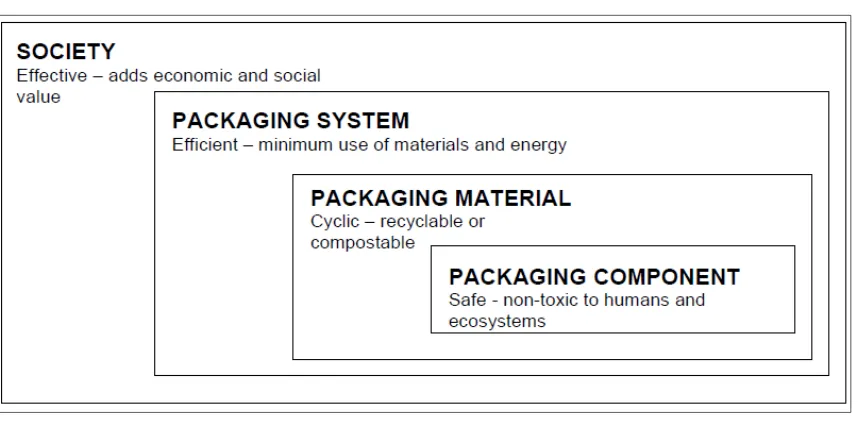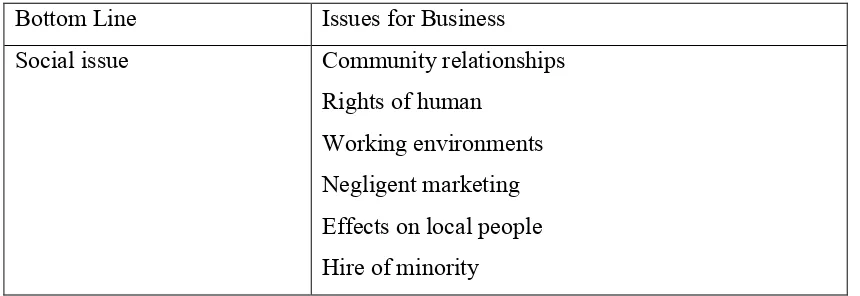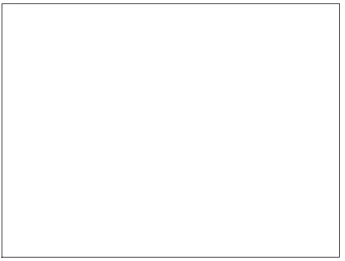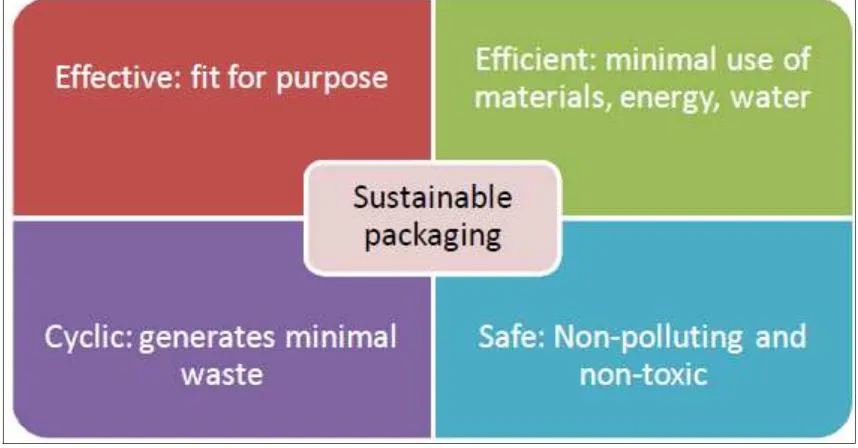UNIVERSITI TEKNIKAL MALAYSIA MELAKA
DEVELOPMENT OF A DATABASE TO SUPPORT
SUSTAINABLE PACKAGING DESIGN
This report submitted in accordance with requirement of the Universiti Teknikal Malaysia Melaka (UTeM) for the Bachelor Degree of Manufacturing Engineering
(Manufacturing Design) (Hons.)
by
JOHN WONG HUANG UNG B051210025
911016135709
i
ABSTRAK
ii
ABSTRACT
iii
DEDICATION
Dedicated to my mother and father Cherished siblings
iv
ACKNOWLEDGEMENT
v
2.1 Definition of Sustainable Packaging 4
2.2 Introduction to Sustainable Packaging Design 5 2.3 Sustainable Development Strategy 6
2.3.1 Sustainable Development 6 2.3.1.1 Triple Bottom Line 7
2.3.2 Sustainability for Corporate 8
2.3.3 Role of Packaging in Sustainable Development 8 2.3.4 Business Case 9 2.4 Packaging Sustainability Framework 11 2.4.1 Effective Packaging 12
vi
2.4.3 Cyclic Packaging 14
2.4.4 Safe Packaging 15
2.5 Packaging Laws and Regulations 17
2.5.1 Regulations to Product Composition during Manufacture 17
2.5.2 Regulations to Reusable Packaging 17
2.5.3 Regulations to Recoverable Nature of Packaging 18
2.6 Packaging and the Environment 20
2.7 Packaging for Electronic Devices 21
2.7.1 Packaging for Electronics Manufacturing Industry 22 2.7.2 Environmental Packaging Benchmark for Electronics 23
2.8 Packaging Level 24
2.8.1 Primary Packaging 25
2.8.2 Secondary Packaging 25
2.8.3 Tertiary Packaging 26
2.9 Packaging Materials 27
2.9.1 Plastic Packaging 28
2.9.1.1 Non-Renewable Thermoplastic 28
2.9.1.2 Renewable Thermoplastic 29
2.9.1.3 Technical Requirements for Plastic Packaging 30
2.9.2 Paperboard Packaging 31
2.9.2.1 Technical Requirements for Paperboard Packaging 33
2.10 Selecting and Applying Tool 33
2.10.1 Life Cycle Map 34
2.10.2 Life Cycle Assesment Software 35
2.11 Summary 36
CHAPTER 3: METHODOLOGY 37
3.1 Introduction 37
3.2 Problem Statement 37
3.3 Packaging Development 38
3.4 Implementing Sustainable in Development Process 39
3.5 Flow of the Project 39
vii
3.7 Database for Sustainable Packaging Design 41
3.8 SQL and JAVA 42
3.9 Proposed Idea for Database Interface Layout 43
3.10 Survey Form 45
3.11 Summary 48
CHAPTER 4: RESULT AND DISCUSSION 49
4.1 Introduction 49
4.2 Database layout flow 49
4.3 User Interface Design 51
4.4 Test Process of a Packaging Design 56
4.5 Survey Result 61
4.6 Discussion of Sustainable Packaging Database 69
4.7 Discussion of Survey Result 70
4.8 Summary 72
CHAPTER 5: CONCLUSION AND RECOMMENDATIONS 73
5.1 Conclusion 73
5.2 Recommendations 74
REFERENCES 76
viii
LIST OF TABLES
2.1 Issues for business by triple bottom line 7
2.2 Criteria of recycled paper, paper pulp, cardboard, and wood content in
packaging for all products 23
2.3 Index and statistic reduction target 24
4.1 The requirement to develop 3 levels of an electronic mouse packaging 56
ix
LIST OF FIGURES
2.1 Four levels and principles of SPA‟s sustainable packaging 5 2.2 The evolution of packaging concerns and regulations 9 2.3 Excessive supermarket food packaging is undermining householders‟ effort
to recycle 10
2.4 Four sustainable packaging principles 11
2.5 Correlation between triple bottom line and effective packaging 12 2.6 Correlation between triple bottom line and efficient packaging 13
2.7 The Green Dot Symbol 14
2.8 Correlation between triple bottom line and efficient packaging 15 2.9 BPA free was introduced to prevent health issues in polycarbonate plastics 16 2.10 Correlation between triple bottom line and efficient packaging 16 2.11 Reusable packaging, the package turns into a cloth hanger 18 2.12 Comparison of MSW incineration recovery and recycling rates in 2011 19 2.13 Interaction of Packaging System with Product, Physical and Macro
Environment 20
2.14 Environmental impact equation in packaging 21
2.15 Philips electric shaver is tampered proof to prevent pilferage 22 2.16 Bubble wrap acts as a first layer for electronic part 25
2.17 Secondary packaging of a DLSR camera 26
x 2.19 Types of non-renewable thermoplastic polymers 28 2.20 Type of polymer in terms of green design rank 29
2.21 Life cycle of a renewable thermoplastic 30
2.22 Several classifications of paper and board 31
2.23 Life cycle of paper and board packaging 32
2.24 Life Cycle Map 34
2.27 COMPASS Software component impact contribution package 35
3.1 New product development process flow 38
3.2 Flow chart of the project 40
3.3 Categories of each packaging 41
3.4 Architecture of SQL 42
3.5 Main page of the database 43
3.6 Instruction and guidelines for the user before starting to decide on the criteria
and options for his/her packaging 44
3.7 Primary packaging level interface 44
3.8 Secondary packaging level interface 45
3.9 Tertiary packaging level interface 45
3.10 Introduction page 46
3.11 Section A: General Information 46
3.12 Section B: Sustainable Packaging Design 47
3.13 Section C: Sustainable Packaging Database 48
4.1 The flow of the database 50
xi
4.3 Specifications input page 53
4.4 Output page 54
4.5 Material details of chlorinated polyethylene 55 4.6 The material production & material recycling of chlorinated polyethylene 55
4.7 The first step to use the database 57
4.8 The electronic mouse packaging specifications 58
4.9 The selected materials for electronic mouse packaging 59 4.10 Material production and material recycling of polyethylene terephthalate 60 4.11 Material production and material recycling of cardboard 60
4.12 Respondents gender 61
4.13 Respondents age group 62
4.14 Occupation of the respondents 63
4.15 The factors involved in packaging design 64
4.16 Knowledge on the term Sustainable Development 65 4.17 Sustainability in packaging design will reduce environmental impact 66
4.18 Respondents understanding on packaging level 67
xii
LIST ABBREVIATIONS, SYMBOLS AND
NOMENCLATURES
SQL - Structured Query Language SPA - Sustainable Packaging Alliance BPA - Bisphenol A
MSW - Municipal Solid Waste DLSR - Digital Single-Lens Reflex GDP - Gross Domestic Product
EU - European Union
TBL - Triple Bottom Line LCA - Life Cycle Assessment
1
CHAPTER 1
INTRODUCTION
This chapter introduces the project title, problem statements, aims, objectives and project scopes.
1.1 Introduction
Sustainable packaging design is a product development link between packaging and the environment. Packaging is a containment, handling, protection and distribution of goods. It can also be referring to design process, evaluation and packaging production. There are many contexts for the definitions of sustainability or sustainable development. Sustainable can be considered in the context of limited resources and the needs of future generations. Sustainable development is a path with a plan to achieve sustainability in activities that uses environmental resources and immediate replacement is needed.
2 In this project, information will be gathered regarding packaging materials and components, levels of packaging and packaging design principles. The data are gathered, assembled, categorized and arranged in respective areas. The database will be able to show sustainable packaging guidelines and checklists to inform packaging design. This will help packaging designer in manufacturing field to design packaging for their products in a sustainable and economic way.
1.2 Problem Statement
Most of the packaging designer design products packaging using concepts generated from ideas to solve their problem. Their design concepts are based on appearances, cost competiveness, and less on environmental aspects. Designing a packaging is an intricate process which requires major marketing area, function and cost as well. Designing for sustainability will increase intricacy to the process of packaging design with time consuming. Designing electronic product packaging is a challenge where the packaging needs to protect the electronic product from static loads, impacts, vibrations and climate changes. Thus, manufacturer will tend to over protect their product which causes waste of production material and consumer often discard the packaging after purchase leads to excessive waste. Thus it gives packaging a negative environmental image (TCGF, 2011).
1.3 Aims
3 designer choose their sustainable packaging design efficiently and effectively which aims to reduce environmental impact and ecological footprint from the packaging.
1.4 Objectives
The objectives of the project are:
a) To review on sustainable packaging design.
b) To develop a database program for sustainable packaging design specifically for consumer electronic products.
c) To test and run the database for effectiveness and efficiency.
1.5 Scope
4
CHAPTER 2
LITERATURE REVIEW
This chapter, it will provide information on sustainable packaging design, development strategy, laws and regulations, environment, packaging design and materials, tools used, and its implementation.
2.1 Definition of Sustainable Packaging
Sustainable packaging is a product development link between packaging and environment to achieve sustainability. The word sustain is derived from old French soustenir and Latin sustinere, from sub „from below‟ + tenere „hold‟ (Oxford Dictionaries). It means to hold, maintain and uphold. Packaging serves to contain, handle, protect and distribute goods/products made from any material of any nature, from raw material to finished goods, from manufacturer to the end user (EC Directive 94/62). Environment is the surrounding of the organization‟s operations which are water, air, earth, natural resources, flora & fauna, humans and their interrelation (ISO 14001 clause 3.5). Thus, implementing sustainability into packaging design serves to design and manufacture packaging that concurrently provides social, economic and environmental value.
5 Figure 2.1, they aim to differentiate between macro levels of society of society related to success, functional performance level of the packaging system, environmental performance level to the micro level of human and eco toxicological soundness of the packaging components (James, 2005).
Figure 2.1: Four levels and principles of SPA‟s sustainable packaging (James, 2005).
2.2 Introduction to Sustainable Packaging Design
6 Packaging undeniable consumes resources and requires energy for manufacturing but technology now is constantly aiming for reducing packaging waste as low as possible. Sustainability in packaging design requires new information such as product and its packaging environmental life cycle, packaging role in attaining sustainable development goals, packaging environment regulatory requirements and systems in place for recovery, use and disposal of packaging at end-of-life (Helen, 2012).
2.3 Sustainable Development Strategy
The concept of sustainable development is rather abstract and theoretical for new business as it an entirely new idea and knowledge (IISD, 2001). Organization or company will have to consider profitability, market share and revenue growth including regulatory requirements in order to accept sustainable development. For businesses to successfully practiced sustainable development for entire operations, they have to make major changes in their strategy, new skills and knowledge development.
2.3.1 Sustainable Development
7
2.3.1.1 Triple Bottom Line
Triple Bottom Line or known as three pillars of sustainability is an approach to consider sustainable development for business. It was introduced by John Elkington in the year of 1997. John Elkington said, health signifies the ultimate bottom line with economy depends on it while society depends on economy (Elkington, 1997). This framework overcomes the traditional method of profits gaining, investment return and shareholder value by including environmental and social dimensions. Therefore, focusing on comprehensive investment results, with respect of interrelated magnitudes of profits, people and the planet, triple bottom line can be an important tool to hold sustainability goals and vision. The three elements can open up huge opportunities and challenges for the business. The TBL and its core value of sustainability attracted in the business due to long term profitability (Timothy, 2011). An example would be waste reduction leads to cost reduction. Cascade Engineering stated that big firms already implemented TBL such as General Electric, Unilever, Protor & Gamble, 3M and Cascade Engineering themselves (Douglas, 2009). For nonprofit organizations, they also adopted the TBL to address wide sustainability issues and cooperate with private companies in hope to achieve wide sustainability issues shown in Table 2.1. These alignments will make good business sense while nonprofit will achieve their economic boost and environmental safety. Elkington summarized the traditional sustainability measures, measures assessed through academic discourse (Elkington, 1997);
Table 2.1: Issues for business by triple bottom line (Elkington, 1997).
Bottom Line Issues for Business
8
Use and protection of natural capital Environmental managing costs
Material, energy and water consumption Solid waste and pollution
Life cycle impacts of products and services Performance against best practice standards
2.3.2 Sustainability for Corporate
It is important that businesses are urged to address worldwide challenges in sustainable development. According to Dow Jones, corporation sustainability is a way to getting a business that forms long-term shareholder value through chances embracement including risk management derived from social, economic and environmental developments. The focus on corporate sustainability is based on two principles, creation of long-term shareholder value in resource-constrained world and opportunities and risks that companies must be aware (Knoepfel, 2010).
2.3.3 Role of Packaging in Sustainable Development
9 policies and industry initiatives can be more focused of LCA and sustainability metrics.
Figure 2.2: The evolution of packaging concerns and regulations (Fitzpatrick, 2011).
For many years, public has voiced out that packaging is bad for the environment due to litter, waste and even endangers marine life. The regulatory and political action responded to them when the pressure on the land for disposal availability and waste increasing management cost. Then the term sustainable packaging came as a new approach and becoming more evident globally in government policy and industry regulation. Now these developments provoked the The Consumer Goods Forum which representing 650 retailers, manufactures, service providers and other stakeholders across 70 countries in 2008 (TCGF, 2008).
2.3.4 Business Case
10 perspective. An example would be companies may be focusing on weight reduction thus lower material input, reduced transport, lower carbon emissions but the weight reduction will have consequences too. It can be a greater waste if the packaging becomes too fragile and not recyclable as shown in Figure 2.3.
Figure 2.3: Excessive supermarket food packaging is undermining householders‟ effort to recycle
(Source: <http://myzerowaste.com/2009/02/excessive-supermarket-food-packaging-is-undermining-householders-efforts-to-recycle/>, 22/10/2014).
11
2.4 Packaging Sustainability Framework
A sustainability framework is useful as a decision support tool to integrate new approaches required for addressing sustainability efficiently and effectively. The framework was introduced by Sustainable Packaging Alliance in 2002 and improved in 2010. The framework in Figure 2.4 consists of four principles to guide decisions making about design, manufacturing, transport, use and recovery of packaging (SPA 2010).
Figure 2.4: Four sustainable packaging principles (SPA, 2010).




